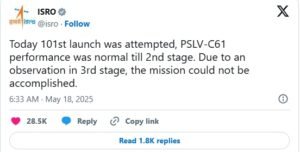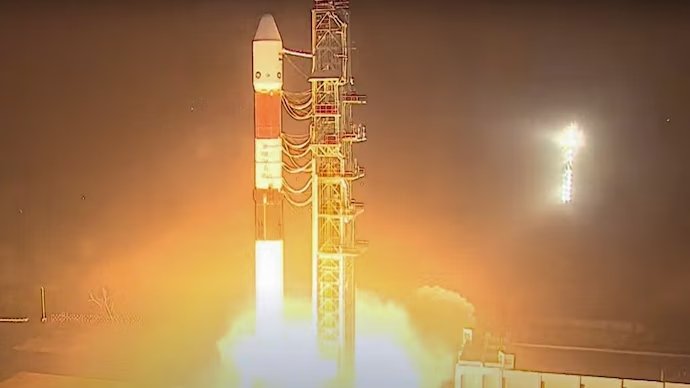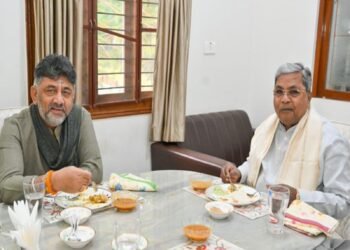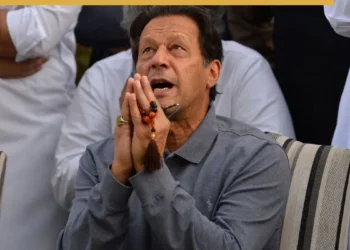On Sunday, the Indian Space Research Organisation (ISRO) successfully launched its 101st satellite, EOS-09, using the Polar Satellite Launch Vehicle (PSLV-C61), but it failed shortly after.
The PSLV-C61 facilitated the 101st launch, transporting an Earth Observation Satellite called EOS-09, intended for placement into a Sun Synchronous Polar Orbit (SSPO). However, the EOS-09 mission could not be completed. As per the ISRO Chief, the PSLV 4-stage vessel performed normally until the second stage.

Significantly, this launch was also in line with advancing sustainability and conducting responsible space missions, as the EOS-09 comes with deorbiting fuel to ensure its safe disposal post-mission.
ALSO READ: Meghalaya Speaker Supports Inquiry into RIMS, Imphal Hanging Case
63rd flight of the PSLV rocket
This marks the 63rd flight of the PSLV rocket and the 27th utilizing the PSLV-XL, achieving a total of 100 launches prior to May 18.
“This mission continues the PSLV’s record of delivering reliable performance across a wide range of payloads and orbits,” read a statement from ISRO.
EOS-09 is a sophisticated Earth observation satellite that features C-band synthetic aperture radar capabilities. It can take high-resolution pictures of the Earth’s surface in any weather, whether it’s day or night. This capability improves India’s monitoring and management systems in various sectors.
Earlier on Saturday, Scientist W Selvamurthy praised the ISRO scientists, technicians, and industries connected with the space organisation for the satellite launch.
Emphasizing the significance of the satellites, he noted that EOS-09 is a member of a constellation of satellites that will be used in agriculture, forestry, disaster response, and even for strategic and military purposes.
“I would like to congratulate the ISRO scientists, technicians, industries associated with ISRO for this important satellite being launched from the Satish Dhawan Space Centre, Sriharikota. It is a very important satellite because it forms a part of a constellation of satellites which can look at Earth and what changes are happening on Earth. For example, agriculture, forestry, disaster management, or even for strategic applications, for military applications, because it’s very important to see the borders,” Selvamurhthy told ANI.
Families and children who got up early to watch the launch from Satish Dhawan Space Centre at Sriharikota expressed their enthusiasm for ISRO’s historic event after traveling long distances, but they felt disheartened to find out that spectators were barred from viewing the launch at the SDSS because of security issues stemming from India-Pakistan tensions.
ALSO READ: Charminar Blaze: Short Circuit Sparks Fire; Flammable Goods Fuel Tragedy
Failures in PSLV missions have been rare
Historically, failures in PSLV missions have been infrequent, with just a few occurrences since its introduction in 1993. Earlier failures have frequently been associated with problems during stage separation or propulsion discrepancies, including attitude control issues or the inadequate performance of a specific stage.
During the inaugural flight in 1993, a programming mistake and a retro-rocket failure caused the loss of attitude control at the separation between the second and third stages, leading to a failed mission.
Another significant failure in 2017 was linked to the payload fairing not detaching, which resulted in the satellite being stuck within the rocket.
For PSLV-C61, failures can arise from different reasons, such as issues in the propulsion system, mistakes during stage separation, or problems in the guidance and control systems.
The space agency has stated that a committee for failure analysis will meticulously examine the telemetry and flight information to identify the precise cause and take corrective actions.













